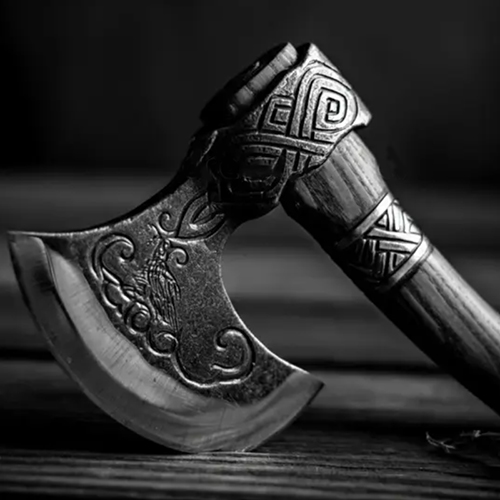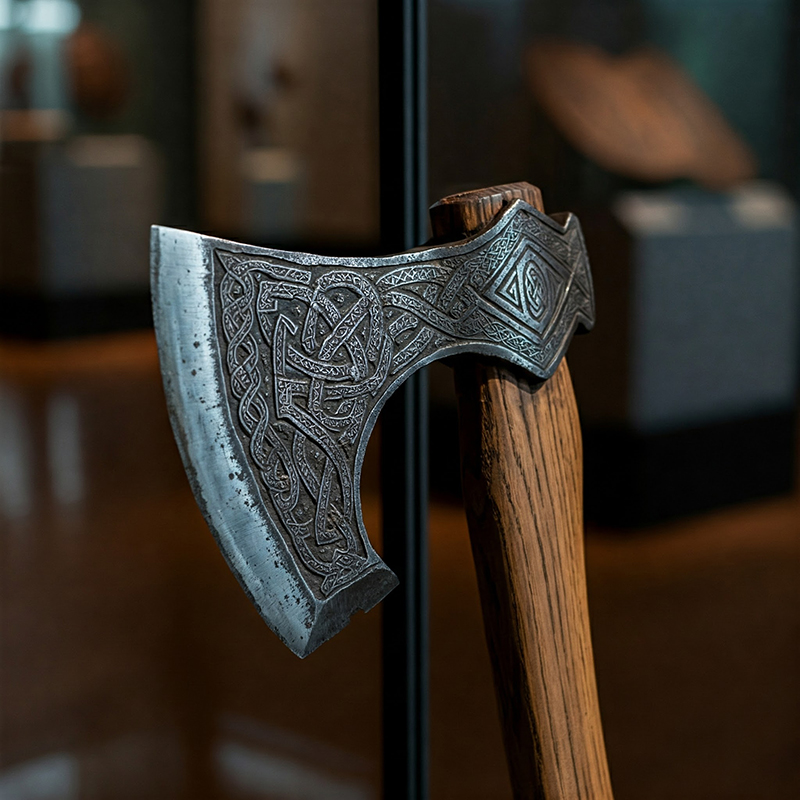Viking Blog
Viking Axe: The Symbol of Power and Masterpiece of Intricate Craftsmanship
Few artifacts from history evoke the same sense of awe and mystery as the Viking axe. More than a weapon of war, it was a tool of survival, a symbol of status, and a canvas for artistic expression. This iconic artifact shows the Norse people’s strength and spirit. It is a fascinating subject to explore.
The Viking Axe: Beyond a Weapon
For the Vikings, axes were far more than instruments of battle. They were versatile tools integral to daily life in the harsh Scandinavian environment. From felling trees for homes and ships to daily chores, the axe was vital. Swords were expensive and for the wealthy. Axes were cheap and available to the poorest Vikings. They were vital in Norse society.
A Weapon Forged for Efficiency
Unlike the modern view of axes as crude, Viking axes were precise, efficient tools. The wide variety of weapons, from small hand axes to massive two-handed Dane axes, allowed for versatile combat. Lightweight and often equipped with long handles, they enabled swift and powerful strikes. Some had crescent-shaped blades to hook an enemy’s shield or weapon. This showed the Vikings’ strategic ingenuity.
A Mark of Status and Identity
In Viking society, the axe was more than a tool. It was a symbol of identity and status. A fine axe, often with carvings or silver inlays, showed the owner’s wealth and status. Warriors with ornate axes were both feared and influential.
The axe had deep cultural and spiritual significance. It was often linked to Norse gods and mythology. Thor, the god of thunder, wielded Mjölnir, a mighty hammer. It has symbolic similarities to the axe. Both weapons came to symbolize the Vikings’ protection, courage, and spirit.
Craftsmanship: Where Function Met Artistry
Viking axes are a testament to the exceptional craftsmanship of Norse blacksmiths. These skilled artisans turned iron and steel into art. Their work balanced form and function, reflecting their culture’s values.
One of the most striking features of Viking axes is their ornate decoration. Handles were often carved with intricate patterns from Norse myths. They depicted dragons, serpents, and other mythical creatures. Some blades might have etched symbols or runes. People believe that they give the weapon magical powers or invoke the gods’ favor.
Pattern welding was often used to improve the blade. It involves layering and forging different metals to create unique designs. These decorations turned the axe from a tool into a status symbol. They showcased the skill and creativity of Viking blacksmiths.
The Axe in Battle: A Fearsome Force
On the battlefield, the Viking axe was a weapon that inspired great fear. Its versatility allowed for many fighting styles. They ranged from powerful overhead strikes to precise hooking moves. Larger two-handed axes, like the Dane axe, were deadly. They could cleave through armor and shields. These weapons needed great strength and skill to wield. So, elite warriors, called berserkers, chose them.
Historical accounts and sagas tell of Viking warriors. They wielded axes and struck fear into their enemies. The Battle of Stamford Bridge in 1066 provides a legendary example. A lone Viking, with a massive axe, held off a Saxon army at a narrow bridge. This showed the axe’s power and the warrior’s spirit.
The Legacy of the Viking Axe
Today, the Viking axe continues to captivate historians, enthusiasts, and collectors. It symbolizes the Norse people’s ingenuity and resilience. It shows their world and values. Museums worldwide display Viking axes, preserving their legacy for the future.

Craftsmen and reenactors seek to recreate the artistry of Viking axes. So, they like modern reproductions and interpretations of them. The Viking axe is a lasting icon of the Viking Age. It is a historical artifact, a legendary weapon, and an artistic muse.
Conclusion
The Viking axe is more than a weapon. It is a symbol of power, a testament to craftsmanship, and a link to a fascinating past. Its dual role as a tool and a masterpiece shows the Norse people’s creativity. Studying the Viking axe gives us insight into the Vikings. It also deepens our appreciation for their enduring legacy.

